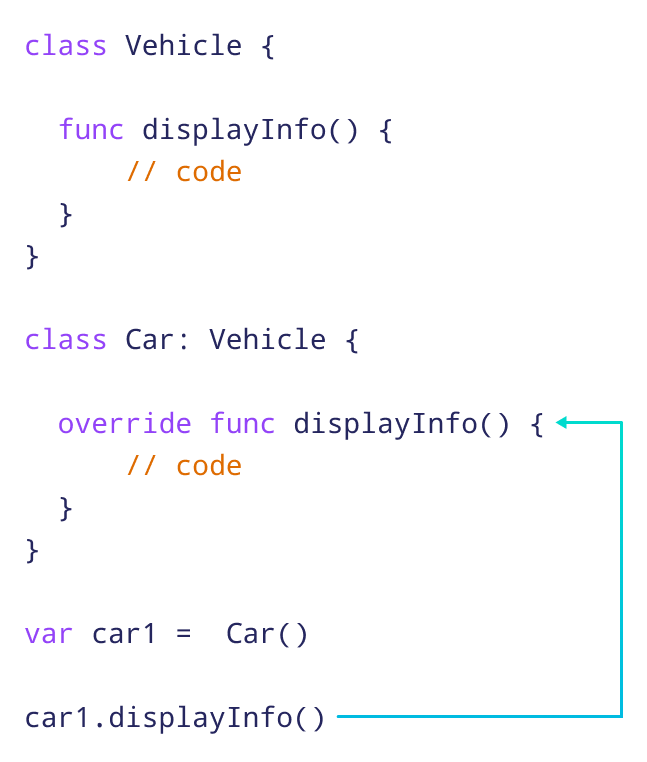在 Swift 继承 中,子类继承了父类的方法和属性。这使得子类可以直接访问父类的成员。
现在,如果在父类和子类中都定义了相同的方法,那么子类中的方法就会覆盖父类中的方法。这被称为覆盖。
我们使用 override 关键字来声明方法覆盖。例如,
class Vehicle {
func displayInfo(){
...
}
}
class Car: Vehicle {
// override method
override func displayInfo() {
...
}
} 在这里,Car 子类中的 displayInfo() 方法覆盖了 Vehicle 父类中同名的方法。
示例:Swift 方法覆盖
class Vehicle {
// method in the superclass
func displayInfo() {
print("Four Wheeler or Two Wheeler")
}
}
// Car inherits Vehicle
class Car: Vehicle {
// overriding the displayInfo() method
override func displayInfo() {
print("Four Wheeler")
}
}
// create an object of the subclass
var car1 = Car()
// call the displayInfo() method
car1.displayInfo()输出
Four Wheeler
在上面的示例中,我们在 Car 子类中覆盖了父类 Vehicle 的 displayInfo() 方法。
// inside the Car class
override func displayInfo() {
print("Four Wheeler")
}这里,我们使用了 override 关键字来指定被覆盖的方法。
现在,当我们使用 Car 的对象 car1 调用 displayInfo() 方法时,
car1.displayInfo()调用的是子类中的方法。

这是因为 Car 子类中的 displayInfo() 方法覆盖了 Vehicle 父类中同名的方法。
在 Swift 中访问被覆盖的方法
要从子类访问父类的方法,我们使用 super 关键字。例如,
class Vehicle {
// method in the superclass
func displayInfo() {
print("Vehicle: Four Wheeler or Two Wheeler")
}
}
// Car inherits Vehicle
class Car: Vehicle {
// overriding the displayInfo() method
override func displayInfo() {
// access displayInfo() of superclass
super.displayInfo()
print("Car: Four Wheeler")
}
}
// create an object of the subclass
var car1 = Car()
// call the displayInfo() method
car1.displayInfo()输出
Vehicle: Four Wheeler or Two Wheeler Car: Four Wheeler
在上面的示例中,Car 子类中的 displayInfo() 方法覆盖了 Vehicle 父类中同名的方法。
在 Car 的 displayInfo() 方法内部,我们使用了
// call method of superclass
super.displayInfo()来调用 Vehicle 的 displayInfo() 方法。
所以,当我们使用 car1 对象调用 displayInfo() 方法时,
// call the displayInfo() method
car1.displayInfo()被覆盖的方法和父类版本的 displayInfo() 方法都会被执行。
防止方法覆盖
在 Swift 中,我们可以阻止方法被覆盖。
为了使一个方法不可被覆盖,我们在父类中声明该方法时使用 final 关键字。例如,
class Vehicle {
// prevent overriding
final func displayInfo() {
print("Four Wheeler or Two Wheeler")
}
}
// Car inherits Vehicle
class Car: Vehicle {
// attempt to override
override func displayInfo() {
print("Four Wheeler")
}
}
// create an object of the subclass
var car1 = Car()
// call the displayInfo() method
car1.displayInfo()在上面的示例中,我们将父类中的 displayInfo() 方法标记为 final。
一旦方法被声明为 final,我们就不能覆盖它。所以当我们尝试覆盖 final 方法时,
override func displayInfo() {
print("Four Wheeler")我们会收到一个错误消息:“error: instance method overrides a 'final' instance method”(错误:实例方法覆盖了一个“final”实例方法)。
覆盖 Swift 属性
在 Swift 中,我们可以覆盖 计算属性。例如,
class University {
// computed property
var cost: Int {
return 5000
}
}
class Fee: University {
// override computed property
override var cost: Int {
return 10000
}
}
var amount = Fee()
// access fee property
print("New Fee:", amount.cost)输出
New Fee: 10000
在上面的示例中,我们在父类 University 中创建了一个计算属性。请注意子类 Fee 中的代码,
override var cost: Int {
return 10000
} 我们正在覆盖计算属性 cost。现在,当我们使用 Fee 的对象 amount 访问 cost 属性时,
// access fee property
amount.cost调用的是子类中的属性。
注意:在 Swift 中,我们不能覆盖存储属性。例如,
class A {
// stored property
var num = 0
}
class B: A {
// overriding stored property
override var num = 2 // Error Code
}